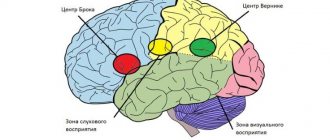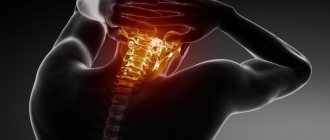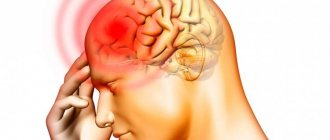Speech depends on many mechanisms that are formed in the first 20 years of life and are closely related to certain areas of the brain hemispheres. Pathological processes or damage to areas of the brain responsible for speech cause aphasia - a speech disorder. In each hemisphere, the functions responsible for speech have motor and sensory support. For example, damage to the premotor area of the cortex, which is responsible for movement, entails the development of afferent or efferent motor aphasia.
Pathology of the cortical part of the auditory analyzer leads to sensory speech impairment. Motor and sensory aphasia are transcortical pathologies. In other words, disturbances that occur during the passage of signals through the cerebral cortex. Motor changes are caused by a decrease in the activity of oral and written speech, sensory changes are caused by speech understanding.
Symptoms
When Wernicke's area is damaged, a person hears everything, but does not understand the content of the words, they do not evoke associations in him; his native language sounds like a foreign language to him. Due to sensory aphasia, a person is unable to identify and distinguish speech sounds.
Speech may remain grammatically correct, but contains many allegories, neologisms (“slang aphasia”), and function words (conjunctions and prepositions). The statements are verbose but uninformative, and the words appear to be in random order. Gestures and facial expressions do not help convey the meaning of statements. The patient does not realize that his speech is impaired and becomes irritated if he is not understood.
The patient does not understand simple questions (such as “what is your name?”).
The understanding of commands addressed to the muscles of the head and trunk (“close eyes”, “sit down”, “turn around”) is preserved - this feature helps to distinguish sensory cortical aphasia from hearing loss, mental illness or malingering.
Written speech is impaired.
Sensory cortical aphasia may be accompanied by severe agitation and a paranoid state.
Thus, sensory cortical aphasia includes both expressive and expressive disorders and is therefore, strictly speaking, purely "sensory" or "receptive". Repetition, naming, reading and writing are also impaired.
Causes of pathology
The risk group for sensory aphasia includes older people and people with heart and vascular diseases.
In children, pathology is recorded much less frequently than in adults. In some cases, the damaging effect on the central nervous system manifests itself immediately, in others, up to several years may pass from the moment the problem appears.
Wernicke's aphasia in an adult can result from the following factors:
- acute cerebrovascular accident. Ischemic and hemorrhagic strokes are considered the most common triggers of the disorder;
- decreased functionality of cerebral vessels. Emboli, tissue hypoxia as a result of narrowing of the lumen of blood channels, instability of blood flow pose a serious danger to the speech functions of the brain;
- traumatic brain injuries. Capable of causing immediate or delayed damage to the tissue structure in the skull;
- benign and malignant formations in the brain;
- aneurysms of cerebral vessels. Acoustic-gnostic aphasia can occur as a result of rupture of the protrusion of the canal wall or its pressure on the cerebral cortex in the temporal region;
- inflammatory lesions of the central nervous system;
- abscesses that can form in the temporal region after a complicated course of otitis media;
- diseases leading to degeneration and demyelination of brain tissue and its membranes.
In childhood, acoustic-gnostic disorder most often results from head trauma. Particularly dangerous are complicated childbirths, the consequences of which may appear several years later. Congenital vascular pathologies, tumors, infections and inflammatory processes also act as increased risk factors.
Accompanying illnesses
Sensory cortical aphasia is often accompanied by right-sided complete hemianopsia or superior quadrant hemianopsia, in some cases there is slight smoothing of the right nasolabial fold - there are usually no other abnormalities. Speech full of neologisms and paraphasia, an excited state and the absence of neurological symptoms sometimes lead to suspect mental illness TIR. The correct diagnosis can be made based on other characteristic features of aphasia and the absence of mental illness before its development.
Treatment
Treatment of pathology is an interdisciplinary problem. The recovery process should be led by several specialists at once - neurologists, speech therapists, neuropsychologists, psychotherapists, physiotherapists.
There is even a specialty in occupational therapy, whose doctors help patients adapt to everyday life with this disorder after a stroke. One of the main tasks of rehabilitation is the stimulation of neuroplastic processes in the brain, due to which new connections are created between neurons and partial or complete restoration of affected functions.
Pharmacotherapy is important to improve metabolism in brain tissue, improve blood supply and prevent recurrent attacks.
An excerpt characterizing Wernicke's Aphasia
“They are deceiving the people,” he repeated. - Lord Jesus Christ! – the wanderer said, crossing herself. - Oh, don't tell me, father. So one anaral did not believe it, he said: “the monks are deceiving,” and as he said, he became blind. And he dreamed that Mother of Pechersk came to him and said: “Trust me, I will heal you.” So he began to ask: take me and take me to her. I’m telling you the real truth, I saw it myself. They brought him blind straight to her, he came up, fell, and said: “Heal! “I will give you,” he says, “what the king gave you.” I saw it myself, father, the star was embedded in it. Well, I have received my sight! It's a sin to say that. “God will punish,” she instructively addressed Pierre. - How did the star end up in the image? – asked Pierre. - Did you make your mother a general? - said Prince Andrei, smiling. Pelagia suddenly turned pale and clasped her hands. - Father, father, it’s a sin for you, you have a son! - she spoke, suddenly turning from pallor to bright color. - Father, what did you say? God forgive you. - She crossed herself. - Lord, forgive him. Mother, what is this?...” she turned to Princess Marya. She stood up and, almost crying, began to pack her purse. She was obviously both scared and ashamed that she had enjoyed benefits in a house where they could say this, and it was a pity that she now had to be deprived of the benefits of this house. - Well, what kind of hunting are you doing? - said Princess Marya. “Why did you come to me?...” “No, I’m joking, Pelageyushka,” said Pierre. - Princesse, ma parole, je n'ai pas voulu l'offenser, [Princess, I'm right, I didn't want to offend her,] I just did that. Don’t think I was joking,” he said, smiling timidly and wanting to make amends. - After all, it’s me, and he was only joking. Pelageyushka stopped incredulously, but Pierre's face showed such sincerity of repentance, and Prince Andrei looked so meekly first at Pelageyushka, then at Pierre, that she gradually calmed down. The wanderer calmed down and, brought back into conversation, talked for a long time about Father Amphilochius, who was such a saint of life that his hand smelled like palm, and about how the monks she knew on her last journey to Kiev gave her the keys to the caves, and how she, taking crackers with her, spent two days in the caves with the saints. “I’ll pray to one, read, go to another. I’ll take a pine tree, I’ll go and take a kiss again; and such silence, mother, such grace that you don’t even want to go out into the light of God.” Pierre listened to her carefully and seriously. Prince Andrei left the room. And after him, leaving God’s people to finish their tea, Princess Marya led Pierre into the living room. “You are very kind,” she told him. - Oh, I really didn’t think of offending her, I understand and highly value these feelings! Princess Marya silently looked at him and smiled tenderly. “After all, I have known you for a long time and love you like a brother,” she said. – How did you find Andrey? - she asked hastily, not giving him time to say anything in response to her kind words. - He worries me very much. His health is better in winter, but last spring the wound opened, and the doctor said that he should go for treatment. And morally I am very afraid for him. He is not the type of character we women are to suffer and cry out our grief. He carries it inside himself. Today he is cheerful and lively; but it was your arrival that had such an effect on him: he is rarely like this. If only you could persuade him to go abroad! He needs activity, and this smooth, quiet life is ruining him. Others don't notice, but I see. At 10 o'clock the waiters rushed to the porch, hearing the bells of the old prince's carriage approaching. Prince Andrei and Pierre also went out onto the porch. - Who is this? - asked the old prince, getting out of the carriage and guessing Pierre. – AI is very happy! “kiss,” he said, having learned who the unfamiliar young man was.
What can interfere with recovery?
A patient’s chances of recovery from sensorimotor aphasia depend on a number of factors, which include the general condition of the patient, the presence of concomitant diseases and the effectiveness of the rehabilitation therapy used. Indeed, it is much more difficult to regain the lost ability to speak and understand speech if the patient:
- repeated hemorrhage occurred;
- atherosclerosis, arterial hypertension or other cardiovascular diseases are diagnosed;
- ischemic attacks often occur;
- progressive diabetes mellitus.
Physiotherapy for speech restoration
Physiotherapeutic procedures are useful for stimulating the speech muscles. For aphasia, acupuncture and electrophoresis are prescribed
.
However, today physical treatment after a stroke is not widespread
.
With local and shallow damage to an area of the cerebral cortex, the techniques actually help to correct articulation, but they are ineffective in restoring the perception of speech heard by the patient. Biofeedback tactics also lack precise confirmation of effectiveness
. Meanwhile, today this treatment tactic is used for visual control over the restoration of the patient’s speech.
Melodic chants to restore speech
When performing exercises for sensorimotor aphasia, experts also focus on the therapy of melodic intonation. This technique is based on activating the functions of the legal cerebral hemisphere. Singing or just your favorite musical compositions will help you achieve the desired result.
.
If you often hum melodic tunes previously familiar to the patient, he will want to one day sing along with his instructor, trying to pronounce the endings of phrases or individual words
.
Tongue twisters that are spoken to a patient who is already recovering also help
. This method works effectively, contributing to the speedy restoration of speech.
Help from a speech therapist: exercises to correct speech function
Speech therapy correction for sensorimotor aphasia is as fundamental a treatment method as the use of medications. To restore the patient’s speech, various exercises are used to activate the activity of the right cerebral hemisphere
.
The set of training sessions described below for a patient who has suffered a stroke is aimed at restoring in his memory the skills of mobility of the jaws, tongue, and lips. It must be performed together with the patient - he must repeat after the instructor
.
To restore speech with sensorimotor aphasia, you need to train every day
speech apparatus
in the following way:
- Fold your lips into a tube, stretch them out as much as possible and hold them in this position for a few seconds, then relax. The exercises are repeated 10 times.
- You need to lightly grab your lower lip with your teeth, as if trying to bite it, then let go and relax. Do the same with the upper lip.
- Stick your tongue out as far as possible, tense your neck and hold your breath for 3 seconds, then exhale. Repeat several times.
- Lick your lips with your tongue, confidently moving it in a circle clockwise and in the opposite direction.
- With maximum tongue tension, try to roll it into a tube, and then touch the tip of it to the upper palate.










